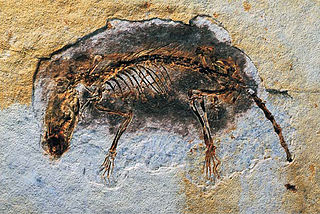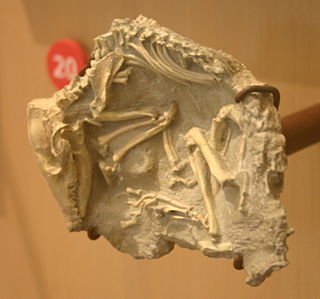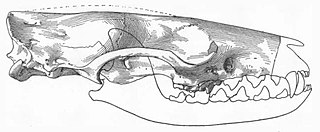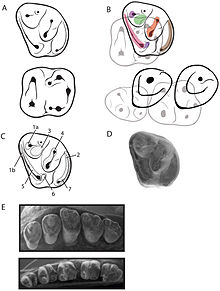
Eomaia is a genus of extinct fossil mammals containing the single species Eomaia scansoria, discovered in rocks that were found in the Yixian Formation, Liaoning Province, China, and dated to the Barremian Age of the Lower Cretaceous about 125 million years ago. The single fossil specimen of this species is 10 centimetres (3.9 in) in length and virtually complete. An estimate of the body weight is 20–25 grams (0.71–0.88 oz). It is exceptionally well-preserved for a 125-million-year-old specimen. Although the fossil's skull is squashed flat, its teeth, tiny foot bones, cartilages and even its fur are visible.

Eutheria is the clade consisting of placental mammals and all therian mammals that are more closely related to placentals than to marsupials.

Euarchontoglires is a clade and a superorder of mammals, the living members of which belong to one of the five following groups: rodents, lagomorphs, treeshrews, primates, and colugos.

Repenomamus is a genus of opossum- to badger-sized gobiconodontid mammal containing two species, Repenomamus robustus and Repenomamus giganticus. Both species are known from fossils found in China that date to the early Cretaceous period, about 125-123.2 million years ago. R. robustus is one of several Mesozoic mammals for which there is good evidence that it fed on vertebrates, including dinosaurs. Though it is not entirely clear whether or not these animals primarily hunted live dinosaurs or scavenged dead ones, evidence for the former is present in fossilized remains showcasing the results of what was most likely a predation attempt by R. robustus directed at a specimen of the dinosaur Psittacosaurus lujiatunensis. R. giganticus is among the largest mammals known from the Mesozoic era.

Glires is a clade consisting of rodents and lagomorphs. The hypothesis that these form a monophyletic group has been long debated based on morphological evidence. Two morphological studies, published in 2001 and 2003, strongly support the monophyly of Glires. In particular, the 2003 study reported the discovery of fossil material of basal members of Glires, particularly the genera Mimotona, Gomphos, Heomys, Matutinia, Rhombomylus, and Sinomylus. Their description, in 2005, helped to bridge the gap between more typical rodents and lagomorphs. Data published in 2001, based on nuclear DNA, supported Glires as a sister of Euarchonta to form Euarchontoglires, but some genetic data from both nuclear and mitochondrial DNA have been less supportive. A study, published in 2007, investigating retrotransposon presence/absence data unambiguously supports the Glires hypothesis. Studies published in 2011 and 2015 place Scandentia as a sister clade of the Glires, invalidating Euarchonta as a clade.

Simplicidentata is a group of mammals that includes the rodents and their closest extinct relatives. The term has historically been used as an alternative to Rodentia, contrasting the rodents with their close relatives the lagomorphs. However, Simplicidentata is now defined as including all members of Glires that share a more recent common ancestor with living rodents than with living lagomorphs. Thus, Simplicidentata is a total group that is more inclusive than Rodentia, a crown group that includes all living rodents, their last common ancestor, and all its descendants. Under this definition, the loss of the second pair of upper incisors is a synapomorphic feature of Simplicidentata. The loss of the second upper premolar (P2) has also been considered as synapomorphic for Simplicidentata, but the primitive simplicidentate Sinomylus does have a P2.

Castorocauda is an extinct, semi-aquatic, superficially otter-like genus of docodont mammaliaforms with one species, C. lutrasimilis. It is part of the Yanliao Biota, found in the Daohugou Beds of Inner Mongolia, China dating to the Middle to Late Jurassic. It was part of an explosive Middle Jurassic radiation of Mammaliaformes moving into diverse habitats and niches. Its discovery in 2006, along with the discovery of other unusual mammaliaforms, disproves the previous hypothesis of Mammaliaformes remaining evolutionarily stagnant until the extinction of the non-avian dinosaurs.

Protungulatum is an extinct genus of eutherian mammals within extinct family Protungulatidae, and is possibly one of the earliest known placental mammals in the fossil record, that lived in North America from the Late Cretaceous to early Paleocene.

Volaticotherium antiquum is an extinct, gliding, insectivorous mammal that lived in Asia during the Jurassic period, around 164 mya. It is the only member of the genus Volaticotherium.

Cimolestes is a genus of early eutherians with a full complement of teeth adapted for eating insects and other small animals. Paleontologists have disagreed on its relationship to other mammals, in part because quite different animals were assigned to the genus, making Cimolestes a grade taxon of animals with similar features rather than a genus of closely related ones. Fossils have been found in North America, South America, Europe and Africa. Cimolestes first appeared during the Late Cretaceous of North America. According to some paleontologists, Cimolestes died out at the start of the Paleocene, while others report the genus from the early Eocene.

Gobiconodon is an extinct genus of carnivorous mammals belonging to the family Gobiconodontidae. Undisputed records of Gobiconodon are restricted to the Early Cretaceous of Asia and North America, but isolated teeth attributed to the genus have also been described from formations in England and Morocco dating as far back as the Middle Jurassic. Species of Gobiconodon varied considerably in size, with G. ostromi, one of the larger species, being around the size of a modern Virginia opossum. Like other gobiconodontids, it possessed several speciations towards carnivory, such as shearing molariform teeth, large canine-like incisors and powerful jaw and forelimb musculature, indicating that it probably fed on vertebrate prey. Unusually among predatory mammals and other eutriconodonts, the lower canines were vestigial, with the first lower incisor pair having become massive and canine-like. Like the larger Repenomamus there might be some evidence of scavenging.
Deltatheroida is an extinct group of basal metatherians that were distantly related to modern marsupials. The majority of known members of the group lived in the Cretaceous; one species, Gurbanodelta kara, is known from the late Paleocene (Gashatan) of China. Their fossils are restricted to Central Asia and North America. This order can be defined as all metatherians closer to Deltatheridium than to Marsupialia.

The Tiaojishan Formation is a geological formation in Hebei and Liaoning, People's Republic of China, dating to the middle-late Jurassic period. It is known for its exceptionally preserved fossils, including those of plants, insects and vertebrates. It is made up mainly of pyroclastic rock interspersed with basic volcanic and sedimentary rocks. Previously, the Tiaojishan Formation was grouped together with the underlying Haifanggou Formation as a single "Lanqi Formation." The Tiaojishan Formation forms a key part of the Yanliao Biota assemblage, alongside the Haifanggou Formation.
The Irdin Manha Formation is a geological formation from the Eocene located in Inner Mongolia, China, a few kilometres south of the Mongolian border.

Juramaia is an extinct genus of very basal eutherian mammal known from the Late Jurassic deposits of western Liaoning, China. It is a small shrew-like mammal with a body length of approximately 70–100 mm, making it similar in size to the modern De Winton's shrew. Juramaia is known from the holotype BMNH PM1343, an articulated and nearly complete skeleton including incomplete skull preserved with full dentition.
This paleomammalogy list records new fossil mammal taxa that were described during the year 2011, as well as notes other significant paleomammalogy discoveries and events which occurred during that year.

Prolimnocyon is an extinct paraphyletic genus of limnocyonid hyaenodonts that lived in Asia and North America during the late Paleocene to middle Eocene. Prolimnocyon chowi is the earliest known member of the hyaenodontid family Limnocyonidae.

Viverravus is an extinct genus of placental mammals from extinct subfamily Viverravinae within extinct family Viverravidae, that lived in North America, Europe and Asia from the middle Paleocene to middle Eocene.

Palaeanodonta is an extinct clade of stem-pangolins. They were insectivorous (myrmecophagous), possibly fossorial, and lived from the middle Paleocene to early Oligocene in North America, Europe and Asia. While the taxonomic grouping of Palaeanodonta has been debated, it is widely thought that they are a sister group to pangolins.

Zalambdalestidae is a clade of Asian eutherians occurring during the Late Cretaceous. Once classified as Glires, features like epipubic bones and various cranial elements have identified these animals as outside of Placentalia, representing thus a specialised clade of non-placental eutherians without any living descendants, and potentially rather different from modern placentals in at least reproductive anatomy.
















